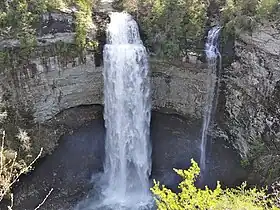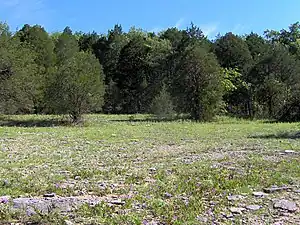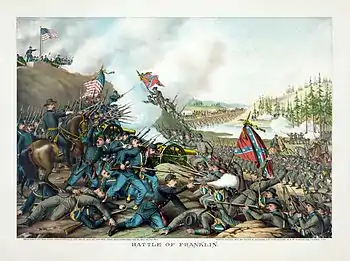Middle Tennessee
Middle Tennessee is one of the three Grand Divisions of Tennessee that composes roughly the central portion of the state. It is delineated according to state law as 41 of the state's 95 counties.[1] Middle Tennessee contains the state's capital and largest city, Nashville, as well as Clarksville, the state's fifth largest city, and Murfreesboro, the state's sixth largest city and largest suburb of Nashville. The Nashville metropolitan area, located entirely within the region, is the most populous metropolitan area in the state, and the Clarksville metropolitan area is the state's sixth most populous. Middle Tennessee is both the largest, in terms of land area, and the most populous of the state's three Grand Divisions.
Middle Tennessee | |
|---|---|
 .jpg.webp)      Images, from top down, left to right: Skyline of Nashville, the Tennessee State Capitol, the Ryman Auditorium, Stones River National Battlefield in Murfreesboro, Vanderbilt University, Fall Creek Falls, Cedars of Lebanon State Park | |
| Nickname(s): Middle TN, Middle Tenn. | |
 The counties of Tennessee highlighted in red that are designated part of Middle Tennessee. | |
| Country | |
| State | |
| Largest city | Nashville |
| Area | |
| • Land | 44,054.2 km2 (17,009.41 sq mi) |
| Population (2020) | 2,883,086 |
| • Density | 65.44/km2 (169.50/sq mi) |
| Demonym | Middle Tennessean |
Geographically, Middle Tennessee is composed of the Highland Rim, which completely surrounds the Nashville Basin. The Cumberland Plateau is located in the eastern part of the region. Culturally, Middle Tennessee is considered part of the Upland South.[2] Commodity crops such as cotton and tobacco were cultivated by migrant settlers in the region in the antebellum era, who were largely dependent on the labor of enslaved African Americans. In addition, planters bred and trained livestock, such as the world-famous Tennessee Walking Horse, which was developed as a breed in the region during this time.
Middle Tennessee was a crucial region during the American Civil War. Tennessee was occupied by Federal troops from 1862 through the end of the war. Many battles and campaigns were waged by Confederates in this region, especially in efforts to control the major rivers. Confederate General Nathan Bedford Forrest conducted extensive raids through this area, destroying many Union assets in the 1864 Battle of Johnsonville. The bloodiest major battle of the American Civil War by the proportion of engaged soldiers who became casualties, the Battle of Stones River, was also fought here.
In the 20th century, the Grand Ole Opry was established in Nashville, enhancing the city as the home of country music. Since the early 1970s, the region has been transformed by the entry of many new economic sectors, including automotive manufacturing, healthcare, finance, technology, tourism, and professional services. Both the Nashville and Clarksville metropolitan areas are among the fastest-growing regions in the nation.
History
Native Americans
Throughout the past 10,000 years, a number of different Native peoples are believed to have inhabited what is now Middle Tennessee. The region is believed to have been rich in game animals favored by Ice Age hunter-gatherers.[3] During the Mississippian period (1000–1600 AD), Native Americans established chiefdoms and constructed numerous earthwork mounds in the region, such as Mound Bottom in Cheatham County and the Castalian Springs site in Sumner County.[4] By the late 17th century, for unknown reasons, there were few Native Americans left in Middle Tennessee, but the Cherokee and the Chickasaw claimed the region as their hunting grounds.[5] Natives that had occupied what is now Middle Tennessee prior to this time may have died as a result of new infectious diseases indirectly introduced by European explorers.[4]
Exploration and colonization
.jpg.webp)
The first Europeans to reach what is now Middle Tennessee were probably an expedition in 1540–1541 led by Spanish conquistador Hernando De Soto.[6][7] By the late 17th century, the French had begun to explore the Cumberland River valley in Middle Tennessee. In 1714, a group of French traders constructed a trading post at a site along the Cumberland River in modern-day Nashville that became known as French Lick. These settlers quickly established an extensive fur trading network with the local Native Americans, but by the 1740s the settlement had largely been abandoned.[8] In the 1750s and 1760s, longhunters from Virginia explored much of Middle Tennessee, especially the Cumberland Plateau.[9] In 1769, French-born fur trader Timothy Demonbreun established residence along the Cumberland River in present-day Nashville.[10]
In 1779, James Robertson and John Donelson led two groups of settlers from the Washington District in what is now East Tennessee to the French Lick.[11] These settlers constructed Fort Nashborough, which they named for Francis Nash, a brigadier general of the Continental Army during the American Revolutionary War.[12] The next year, the settlers signed the Cumberland Compact, which established the Cumberland Association, a representative form of government based on the government known as the Watauga Association that had been established by the settlers of East Tennessee.[13] Fort Nashborough later developed as the city of Nashville, and a number of other settlements were established nearby in the late 18th and early 19th centuries.[14] The first settlements in Middle Tennessee became known as the Cumberland Settlements. In 1790, what is now Tennessee became the Southwest Territory, and the settlements in Middle Tennessee were organized into the Mero District, named after Spanish territorial governor Esteban Rodríguez Miró.[15]
In 1795, a survey conducted by the territorial legislature found that the majority of residents of Middle Tennessee were opposed to statehood, while the majority of residents of East Tennessee, of which there were approximately three times more, were in favor.[16][17] Tennessee was admitted to the Union as the 16th state the following year. During the antebellum era, a slavery-based agrarian economy took hold in Middle Tennessee, especially in the fertile soils of the Nashville Basin.[18] Planters primarily grew cotton in the Nashville Basin, and tobacco and corn were cultivated in the Highland Rim.[19] By 1860, enslaved African Americans composed about 29% of the population of Middle Tennessee.[20] After the election of Abraham Lincoln that year, a majority of Middle Tennesseans voted against the state's ordinance of secession in February 1861. Many of these white voters supported the continuation of slavery, but were skeptical about leaving the Union.
Civil War and Reconstruction

Following the Confederate attack on Fort Sumter in April 1861, which started the Civil War, and President Lincoln's call to raise federal troops in response, many Middle Tennesseans changed their opinions about secession. In June 1861, Middle Tennessee voted in favor of Tennessee's second ordnance of secession, which resulted in Tennessee joining the Confederate States of America (CSA),[21] although a few counties in the extreme southwest (Wayne) and northeast (Macon and Fentress) continued to favor the Union.
A number of crucial campaigns and battles of the Civil War took place in Middle Tennessee. General Ulysses S. Grant and the U.S. Navy captured control of the Tennessee and Cumberland rivers in February 1862 at the battles of Fort Henry and Fort Donelson, essentially establishing Union control of Middle Tennessee.[22] Union troops occupied the state for the duration of the war.
Union strength in the area, however, was tested by a series of Confederate offensives beginning in the summer of 1862, which culminated in Union General William Rosecrans's Army of the Cumberland routing Confederate General Braxton Bragg's Army of Tennessee at the Battle of Stones River in Murfreesboro in December 1862 and January 1863.[23] This was one of the bloodiest battles of the entire war.[23] In February, the Confederates took about 670 to 870 casualties in the Battle of Dover when Colonel Abner C. Harding defeated the 2500 Confederate troops with 800 Union soldiers. The next summer, Rosecrans's Tullahoma campaign forced Bragg's remaining troops in Middle Tennessee to flee to Chattanooga with little fighting.[24] The last major battles in Middle Tennessee occurred during the Franklin–Nashville campaign in the fall of 1864, when the Army of Tennessee under the command of General John Bell Hood unsuccessfully tried to lure Union General William Tecumseh Sherman, who was conducting the Atlanta campaign in Georgia, back into the region. Hood was defeated at the Battle of Franklin in November, then completely dispersed from the state by General George Thomas at the Battle of Nashville the following month.[25] The United States Colored Troops (USCT) played a major role in this campaign.[25]
During Reconstruction, Middle Tennessee's economy fell into a state of disrepair. The Ku Klux Klan was formed in Pulaski in December 1865 as a vigilante organization to advance the interests of former Confederates, including maintenance of white supremacy.[26] In the years following the Civil War, African Americans and their White allies in Middle Tennessee were targeted with acts of violence by former Confederates. Many freedmen (former slaves) became sharecroppers following the end of slavery, and were often disadvantaged by the planters' recordkeeping and contracts.
Late 19th and earlier 20th century
The post-Reconstruction era in Middle Tennessee was characterized by continued White violence against African Americans, especially related to elections, and many were lynched in a cycle often related to economic tensions and settlement of finances after harvest. In the late 19th century, African Americans began fleeing Middle Tennessee to booming industrial cities in the Northeast and Midwest. This mass migration, which occurred in every Southern state and accelerated between 1915 and 1930, became known as the first wave of the Great Migration. It continued until 1970.
The region's economy continued to be based primarily on agriculture, but coal mining expanded extensively in the Cumberland Plateau in Middle Tennessee in the late 19th and early 20th centuries.[27] In 1897, Tennessee celebrated its centennial of statehood one year late with the Tennessee Centennial and International Exposition in Nashville.[28] A full-scale replica of the Parthenon in Athens was designed by architect William Crawford Smith and constructed for the celebration, owing to the city's reputation as the "Athens of the South."[29] The site of the exposition is now a city park called Centennial Park.[30]
The worst rail accident in U.S. history occurred on July 9, 1918, in Nashville when two passenger trains collided head on, killing 101 people and injuring 171. Human error was ultimately deemed to be the main cause of the accident.[31]
The Grand Ole Opry was first broadcast in 1925 in Nashville, and remains the longest-running radio program in the nation. This radio program helped establish Nashville as the national home of country music.[32]
During World War II Camp Forrest, located in Tullahoma, was one of the U.S. Army's largest training bases. It was also used to house German, Italian, and Japanese prisoners of war. After the war, it was adapted as Arnold Air Force Base. The Vultee Aircraft Corporation operated a plant in Nashville during the war, employing mostly women.
On February 25 and 26, 1946, a civil disturbance known as the "Columbia Race Riot" occurred in Columbia, instigated by a fight between a Black Navy veteran and a White repair apprentice.[33] Described by the press as the "first major racial confrontation" following World War II, the event garnered national attention. It marked a new era of resistance by African-American veterans and others following their participation in World War II, which they believed had earned them their full rights as citizens.[34]
Mid 20th century to present
During the early years of the civil rights movement, the Highlander Folk School near Monteagle provided training to a number of activists in the movement, including Martin Luther King Jr., Ralph Abernathy, John Lewis, and Rosa Parks. The Nashville Student Movement was organized as part of workshops on nonviolence taught by activist James Lawson. Between February and May 1960, the group organized a series of sit-ins at segregated lunch counters in Nashville, which successfully resulted in the desegregation of facilities in the city.[35]
The construction of the Interstate Highway System in the latter 20th century facilitated suburbanization in the region and brought new industries to Middle Tennessee. Since 1970, the Nashville and Clarksville metropolitan areas have been two of the fastest-growing regions in the United States. This growth has accelerated since 1990, causing Middle Tennessee to surpass East Tennessee as the most populous of the state's grand divisions in the 2000s. The region's economy has been transformed by new economic sectors, including the automotive,[36] healthcare,[37] banking,[38] technology,[39] and entertainment industries.
Geography
Unlike the geographic designations of regions of most U.S. states, the term "Middle Tennessee" has legal as well as socioeconomic and cultural meaning. Middle Tennessee, comprises one of the state's three Grand Divisions, whose boundaries are defined by state law. The others are East Tennessee and West Tennessee, each with distinctive history, geography, and demographics. The total land area of Middle Tennessee is 17,009.41 square miles (44,054.2 km2), representing 41.27 percent of the state's total land area.
According to custom, Middle Tennessee consists of the portion of the state east of the Tennessee River's western crossing of the state (in which it flows northward back into Tennessee after having flowed through northern Alabama) and west of the dividing line between the Eastern and Central time zones. Exceptions to this rule are that Hardin County, which is bisected by the Tennessee River, is defined by state law to be entirely within West Tennessee and that Bledsoe, Cumberland, and Marion counties are defined as part of East Tennessee despite being in the Central Time Zone. Consequently, Sequatchie County is often considered part of East Tennessee, despite being defined by law as part of Middle Tennessee. Two northeastern counties of Middle Tennessee, Fentress and Pickett, that supported the Union during the American Civil War are sometimes culturally considered part of East Tennessee, which had strongly supported the Union.
Topography

Most of Middle Tennessee is located within the Highland Rim and Nashville Basin, both of which are part of the Interior Low Plateaus of the larger Interior Plains.[40] The Highland Rim is an elevated plain that which completely surrounds the Nashville Basin, a geological dome.[41] Both regions are characterized by porous limestone bedrock that lies close to the surface of the ground. This results in karst, which forms caves, underground streams, sinkholes, and depressions throughout the region.[42]
The Highland Rim is often divided into eastern and western halves. The Eastern Highland Rim is relatively flat, with gentle rolling hills, and the eastern Nashville Basin has similar terrain, but is dotted with more distinct hills in places. The western Nashville Basin and Western Highland Rim are more rugged, consisting of irregular knob-like hills separated by steep ravines and crooked stream valleys.[41] The eastern Highland Rim has a higher average elevation, however, than the western portion.[41] The eastern portion of Middle Tennessee consists of the western portion of the Cumberland Plateau, part of the larger Appalachian Plateau of the Appalachian Mountains.[43]
The Cumberland Plateau has an average elevation of 2,000 feet (610 m), and is characterized by flat-topped tablelands separated by long, crooked stream valleys and rocky cliffs with numerous waterfalls.[44][45] Middle Tennessee's highest elevation, at 2,382 feet (726 m), is found on the Cumberland Plateau in Grundy County.[46]
Counties
Under the most common definition, the following 41 counties are included in Middle Tennessee:
- Bedford
- Cannon
- Cheatham
- Clay
- Coffee
- Davidson
- DeKalb
- Dickson
- Fentress
- Franklin
- Giles
- Grundy
- Hickman
- Houston
- Humphreys
- Jackson
- Lawrence
- Lewis
- Lincoln
- Macon
- Marshall
- Maury
- Montgomery
- Moore
- Overton
- Perry
- Pickett
- Putnam
- Robertson
- Rutherford
- Sequatchie
- Smith
- Stewart
- Sumner
- Trousdale
- Van Buren
- Warren
- Wayne
- White
- Williamson
- Wilson
The Official Tourism Website of Tennessee has a definition of Middle Tennessee slightly different from the legal definition; the website includes Cumberland County while excluding Grundy and Sequatchie counties.[47]
Population and demographics
| Census | Pop. | Note | %± |
|---|---|---|---|
| 1790 | 7,042 | — | |
| 1800 | 32,183 | 357.0% | |
| 1810 | 160,360 | 398.3% | |
| 1820 | 290,674 | 81.3% | |
| 1830 | 381,892 | 31.4% | |
| 1840 | 419,129 | 9.8% | |
| 1850 | 483,179 | 15.3% | |
| 1860 | 504,431 | 4.4% | |
| 1870 | 558,336 | 10.7% | |
| 1880 | 661,870 | 18.5% | |
| 1890 | 708,584 | 7.1% | |
| 1900 | 778,192 | 9.8% | |
| 1910 | 803,672 | 3.3% | |
| 1920 | 828,382 | 3.1% | |
| 1930 | 868,396 | 4.8% | |
| 1940 | 956,659 | 10.2% | |
| 1950 | 1,023,994 | 7.0% | |
| 1960 | 1,105,138 | 7.9% | |
| 1970 | 1,236,614 | 11.9% | |
| 1980 | 1,510,077 | 22.1% | |
| 1990 | 1,684,825 | 11.6% | |
| 2000 | 2,081,346 | 23.5% | |
| 2010 | 2,455,911 | 18.0% | |
| 2020 | 2,883,086 | 17.4% | |
| Source: 1910–2020[48] | |||
Middle Tennessee is the largest in area and most populated of the state's three Grand Divisions. At the 2020 census it had 2,883,086 inhabitants living in its 41 counties, an increase of 427,175, or 17.39%, over the 2010 figure of 2,455,911 inhabitants.[49] This represented the region's largest net population increase in history.[48] Its population was 41.72 percent of the state's total. Its population density was 169.50 inhabitants per square mile (65.44/km2), making it the second-most densely populated Grand Division, behind East Tennessee. Prior to the 2010 census, Middle Tennessee was the second-most populous of the state's Grand Divisions, behind East Tennessee.
Cities and metropolitan areas
Nashville, the state's capital and largest city, is located in north-central Middle Tennessee. It has nearly 700,000 residents, and anchors a 13-county metropolitan area with about 2 million residents that has been Tennessee's largest since the early 1990s. Clarksville, with a population of about 170,000, is Middle Tennessee's second-largest city and the fifth-largest statewide. It is located in the northwest corner of the region near Kentucky. Murfreesboro, located about 35 miles (56 km) southeast of Nashville, is Middle Tennessee's third-largest city, with more than 150,000 residents. It is also the sixth-largest city in Tennessee and the largest suburb of Nashville. Other important suburbs of Nashville include Franklin, Hendersonville, Smyrna, Spring Hill, Gallatin, Mount Juliet, Lebanon, Columbia, Dickson, and Springfield.
In addition to the Nashville and Clarksville metropolitan areas, Cookeville, located in the eastern part of the region, and Shelbyville, located about 50 miles (80 km) southeast of Nashville, anchor important population centers in Middle Tennessee. Other important cities in the region include Manchester, McMinnville, Tullahoma, Winchester, Lewisburg, and Lawrenceburg.
| Rank | County | Pop. | |||||||
|---|---|---|---|---|---|---|---|---|---|
.jpg.webp) Nashville  Clarksville |
1 | Nashville | Davidson | 689,447 |  Murfreesboro  Franklin | ||||
| 2 | Clarksville | Montgomery | 166,722 | ||||||
| 3 | Murfreesboro | Rutherford | 152,769 | ||||||
| 4 | Franklin | Williamson | 83,454 | ||||||
| 5 | Hendersonville | Sumner | 61,753 | ||||||
| 6 | Smyrna | Rutherford | 53,070 | ||||||
| 7 | Spring Hill | Maury | 50,005 | ||||||
| 8 | Brentwood | Williamson | 45,373 | ||||||
| 9 | Gallatin | Sumner | 44,431 | ||||||
| 10 | Columbia | Maury | 41,690 | ||||||
Economy
A diversity of sectors drives Middle Tennessee's economy, including music and entertainment, automotive manufacturing, healthcare, and technology. The region's economy is reportedly one of the fastest growing in the United States.[51]
Music and entertainment
Nicknamed "Music City", Nashville is perhaps best known as the home of country music. The Big Three record labels, as well as numerous independent labels, have offices in Nashville, mostly in the Music Row area.[52] Today, Nashville is the second-largest music recording center, behind New York City.[53] Nashville's music industry is estimated to have a total economic impact of about $10 billion per year and to contribute approximately 56,000 jobs to the Nashville area.[54]
Business
The largest service industry in Middle Tennessee is healthcare. More than 300 healthcare firms are based in the Nashville area, including Hospital Corporation of America (HCA), the world's largest private operator of hospitals, Community Health Systems, the largest provider of general hospital services in the United States, Envision Healthcare, Vanguard Health Systems, Ardent Health Services, and LifePoint Health.[55][56] Other important business sectors in the region include banking, finance, insurance, and publishing. The technology sector is also rapidly becoming an important aspect of Middle Tennessee's economy, with such tech giants as Amazon and Oracle pledging investments in the area in 2018 and 2021, respectively, that are expected to employ thousands.[39][57][58] Other major corporations headquartered in Middle Tennessee include Caterpillar Inc. in Nashville, Acadia Senior Living in Franklin, Dollar General in Goodlettsville, Tractor Supply Company and Delek US in Brentwood, and Cracker Barrel in Lebanon.[59]
Industry
Automotive manufacturing is the largest manufacturing sector in Middle Tennessee.[36] Nissan operates an assembly plant in Smyrna, which is the largest automotive assembly plant in North America, and also operates an engine plant in Decherd.[60] General Motors operates an assembly plant in Spring Hill that was formerly the sole manufacturing facility for Saturn Corporation. Nissan relocated its North American headquarters from California to Franklin in 2005,[61] and Mitsubishi Motors did the same in 2019.[62] Bridgestone has its North American corporate headquarters in Nashville, and operates manufacturing facilities throughout the region. Middle Tennessee is home to several automotive parts suppliers scattered throughout the region.[36] Other products manufactured in Middle Tennessee include processed foods, consumer electronics, electrical equipment, computer products, chemicals, and firearms.[63]
Agriculture
Soybeans and tobacco are grown throughout Middle Tennessee, and beef cattle is raised throughout the region. Middle Tennessee is perhaps best known for its horticultural products and for being a prime breeding ground for horses. Warren County is one of the top producers of nursery products in the nation, and is nicknamed the "Nursery Capitol of the World".[64] The soils of the Nashville Basin reportedly produce grasses which are favorable to horses, and as a result, the region is a top equestrian location. The Tennessee Walking Horse was first bred in the region in the late 18th century and is today one of the most recognized horse breeds in the world.[65] The Cumberland Plateau is a major source of timber, and reportedly ranks as one of the top producers of hardwood in the country.[66]
Energy
The Tennessee Valley Authority (TVA) provides electric power to Middle Tennessee. TVA operates coal and gas fired plants in the region, including the Cumberland Fossil Plant, Gallatin Fossil Plant, and the Johnsonville Combustion Turbine Plant, as well as several hydroelectric dams. In addition, TVA also purchases power from dams on the Cumberland River and its tributaries operated by the United States Army Corps of Engineers.[67][68] The largest provider of power to the region, however, is the Browns Ferry Nuclear Plant in northern Alabama, the second-largest nuclear plant in the United States.[69]
Tourism

Tourism plays a major role in Middle Tennessee's economy. Nashville has the largest tourism economy in the state, and contains many attractions, mostly related to its musical heritage.[70] Top attractions in the region include the Grand Ole Opry, Country Music Hall of Fame and Museum, Ryman Auditorium, Gaylord Opryland Resort & Convention Center, Johnny Cash Museum, National Museum of African American Music, Frist Art Museum, The Parthenon, the Tennessee State Museum, and Jack Daniel's Distillery. A number of antebellum residences are preserved in the region, including The Hermitage, the home of Andrew Jackson, the Belle Meade Plantation, and several homes in Franklin. As well as the President James K. Polk Home & Museum in Columbia. The National Park Service preserves two Civil War battlefields in Middle Tennessee: Fort Donelson National Battlefield near Dover, and Stones River National Battlefield in Murfreesboro. In addition, the American Battlefield Trust operates the Franklin Battlefield. The Natchez Trace Parkway begins in Nashville, and runs through the southwestern part of Middle Tennessee. In addition, the state operates many state parks in Middle Tennessee that preserve historic sites and natural features of the region.
Education
Middle Tennessee has an abundance of institutions of higher learning—most notably Vanderbilt, Belmont, Lipscomb, and Tennessee State universities in Nashville and Tennessee Tech University in Cookeville. Other prominent universities are Austin Peay State University in Clarksville, the University of the South in Sewanee, Cumberland University in Lebanon, University of Tennessee Southern in Pulaski and Middle Tennessee State University in Murfreesboro, which is the state's second-largest institution of higher learning, just behind the University of Tennessee in Knoxville.
Legal structure
Unlike the geographic designations of regions of most U.S. states, the term Middle Tennessee has legal as well as socioeconomic meaning.[71] Middle Tennessee, West Tennessee, and East Tennessee are the state's three Grand Divisions. According to the Tennessee State Constitution, no more than two of the state supreme court's five justices can come from any one Grand Division. The Supreme Court rotates meeting in courthouses in each of the three divisions. The Supreme Court building for Middle Tennessee is in Nashville. A similar rule applies to certain other commissions and boards, in order to prevent a geographic bias.[72]
Health care
Climate
| Month | Jan | Feb | Mar | Apr | May | Jun | Jul | Aug | Sep | Oct | Nov | Dec | Year |
|---|---|---|---|---|---|---|---|---|---|---|---|---|---|
| Record high °F (°C) | 78 (26) |
85 (29) |
89 (32) |
91 (33) |
96 (36) |
109 (43) |
107 (42) |
106 (41) |
105 (41) |
99 (37) |
88 (31) |
79 (26) |
109 (43) |
| Mean maximum °F (°C) | 68.5 (20.3) |
73.3 (22.9) |
80.1 (26.7) |
85.3 (29.6) |
89.9 (32.2) |
94.7 (34.8) |
97.1 (36.2) |
96.7 (35.9) |
93.4 (34.1) |
86.4 (30.2) |
78.1 (25.6) |
69.6 (20.9) |
98.5 (36.9) |
| Average high °F (°C) | 49.1 (9.5) |
53.8 (12.1) |
62.7 (17.1) |
72.6 (22.6) |
80.4 (26.9) |
87.7 (30.9) |
90.9 (32.7) |
90.4 (32.4) |
84.4 (29.1) |
73.5 (23.1) |
61.4 (16.3) |
52.2 (11.2) |
71.6 (22.0) |
| Daily mean °F (°C) | 39.6 (4.2) |
43.4 (6.3) |
51.5 (10.8) |
60.8 (16.0) |
69.3 (20.7) |
77.1 (25.1) |
80.7 (27.1) |
79.7 (26.5) |
73.1 (22.8) |
61.7 (16.5) |
50.3 (10.2) |
42.7 (5.9) |
60.8 (16.0) |
| Average low °F (°C) | 30.1 (−1.1) |
33.0 (0.6) |
40.2 (4.6) |
48.9 (9.4) |
58.3 (14.6) |
66.4 (19.1) |
70.5 (21.4) |
69.0 (20.6) |
61.8 (16.6) |
49.9 (9.9) |
39.2 (4.0) |
33.3 (0.7) |
50.1 (10.1) |
| Mean minimum °F (°C) | 11.2 (−11.6) |
15.4 (−9.2) |
22.7 (−5.2) |
32.7 (0.4) |
43.1 (6.2) |
55.2 (12.9) |
62.4 (16.9) |
60.2 (15.7) |
47.3 (8.5) |
33.3 (0.7) |
23.5 (−4.7) |
17.4 (−8.1) |
9.0 (−12.8) |
| Record low °F (°C) | −17 (−27) |
−13 (−25) |
2 (−17) |
23 (−5) |
34 (1) |
42 (6) |
51 (11) |
47 (8) |
36 (2) |
26 (−3) |
−1 (−18) |
−10 (−23) |
−17 (−27) |
| Average precipitation inches (mm) | 4.02 (102) |
4.47 (114) |
4.52 (115) |
4.72 (120) |
5.02 (128) |
4.36 (111) |
4.16 (106) |
3.79 (96) |
3.80 (97) |
3.36 (85) |
3.86 (98) |
4.43 (113) |
50.51 (1,283) |
| Average snowfall inches (cm) | 2.0 (5.1) |
1.5 (3.8) |
0.7 (1.8) |
0.0 (0.0) |
0.0 (0.0) |
0.0 (0.0) |
0.0 (0.0) |
0.0 (0.0) |
0.0 (0.0) |
0.0 (0.0) |
0.1 (0.25) |
0.4 (1.0) |
4.7 (12) |
| Average precipitation days (≥ 0.01 in) | 10.8 | 10.9 | 11.6 | 11.2 | 11.6 | 10.7 | 10.3 | 9.4 | 7.8 | 8.4 | 9.0 | 11.4 | 123.1 |
| Average snowy days (≥ 0.1 in) | 2.0 | 1.9 | 0.9 | 0.0 | 0.0 | 0.0 | 0.0 | 0.0 | 0.0 | 0.0 | 0.2 | 0.5 | 5.5 |
| Average relative humidity (%) | 70.4 | 68.5 | 64.6 | 63.2 | 69.5 | 70.4 | 72.8 | 73.1 | 73.7 | 69.4 | 70.2 | 71.4 | 69.8 |
| Average dew point °F (°C) | 26.4 (−3.1) |
29.5 (−1.4) |
36.9 (2.7) |
45.1 (7.3) |
55.9 (13.3) |
63.9 (17.7) |
68.0 (20.0) |
66.9 (19.4) |
61.2 (16.2) |
48.4 (9.1) |
39.4 (4.1) |
31.3 (−0.4) |
47.7 (8.7) |
| Mean monthly sunshine hours | 139.6 | 145.2 | 191.3 | 231.5 | 261.8 | 277.7 | 279.0 | 262.1 | 226.4 | 216.8 | 148.1 | 130.6 | 2,510.1 |
| Percent possible sunshine | 45 | 48 | 52 | 59 | 60 | 64 | 63 | 63 | 61 | 62 | 48 | 43 | 56 |
| Average ultraviolet index | 2 | 4 | 6 | 7 | 9 | 10 | 10 | 9 | 7 | 5 | 3 | 2 | 6 |
| Source 1: NOAA (relative humidity, dew point, and sun 1961−1990)[73][74][75] | |||||||||||||
| Source 2: Weather Atlas (UV index)[76] | |||||||||||||
The weather in Nashville is a decent mix of extremes. Plenty of sunshine in the summer, and crisp, cold air throughout the winter.
Transportation
Roads
Interstate 40 (I-40) traverses Middle Tennessee in an east to west alignment, passing through Nashville and its suburbs to the east. Interstate 65 (I-65) runs north to south through the region, serving Nashville and its suburbs to the north and south, including Brentwood, Franklin, and Spring Hill. Interstate 24 (I-24) enters the region in Clarksville and runs in a southeast to northwest alignment, passing through Nashville and its southeastern suburbs of La Vergne, Smyrna, and Murfreesboro, before exiting the region in the southeast. I-440 serves as a bypass around downtown Nashville, and I-840 is an outer bypass around Nashville, passing though suburban counties to the south. Other important freeways in Middle Tennessee include State Route 155 (SR 155/Briley Parkway), a northern bypass around downtown Nashville, Ellington Parkway, part of U.S. Route 31E (US 31E) in Nashville, SR 386 (Vietnam Veterans Boulevard), which serves Nashville's northwestern suburbs of Hendersonville and Gallatin, and SR 396 (Saturn Parkway), which connects Spring Hill and its General Motors plant to I-65. Middle Tennessee also has several other important corridors that are part of the National Highway System (NHS), including U.S. Routes 43, 64, 70S, 79, and 231, and State Routes 55 and 111.[77][78]

Air, rail, and water
Nashville International Airport (BNA) is the region's primary airport and the busiest airport in Tennessee.[79] The WeGo Star is a commuter rail service that serves Nashville and its eastern suburbs of Mt. Juliet and Lebanon.[80] CSX Transportation operates most freight trackage in Middle Tennessee, and runs a classification yard in Nashville called Radnor Yard.[81] Both the Cumberland and Tennessee rivers are navigable in Middle Tennessee.[82]
Notes
- Mean monthly maxima and minima (i.e. the expected highest and lowest temperature readings at any point during the year or given month) calculated based on data at said location from 1991 to 2020.
- Official records for Nashville were kept at downtown from December 1973 to December 1939, and at Nashville Int'l since January 1940. For more information, see Threadex
References
- "Tennessee Blue Book 2015-2016" (PDF). sos.tn.gov. Nashville: Tennessee Secretary of State. 2015. p. 639. Retrieved June 5, 2021.
- Jordan-Bychkov, Terry G. (2003). The Upland South: The Making of an American Folk Region and Landscape. Center for American Places. p. 9. ISBN 9781930066083. Retrieved June 13, 2021 – via Google Books.
- Satz, Ronald (1979). Tennessee's Indian Peoples. Knoxville, Tennessee: University of Tennessee Press. pp. 3–4. ISBN 978-0-87049-285-3 – via Internet Archive.
- Satz (1979), pp. 8–11
- Satz (1979), p. 14
- Corlew 1981, pp. 25–26.
- Langsdon 2000, p. 4-5.
- Albright 1909, pp. 18–19.
- Finger 2001, pp. 40–42.
- Corradetti, Alex (June 27, 2021). "Exploring the Demonbreun Cave, Nashville's first residence". WKRN-TV. Nashville. Retrieved December 22, 2021.
- Corlew 1981, pp. 53.
- Albright 1909, pp. 49–50.
- Albright 1909, pp. 68–72.
- "Founding of Nashville". Nashville Metropolitan Government Archives. Nashville Public Library. Retrieved May 2, 2021.
- Albright 1909, pp. 152–154.
- Langsdon 2000, p. 22.
- Corlew 1981, p. 95.
- Corlew 1981, pp. 209–212.
- Lamon 1980, pp. 9–12.
- Almond 1980, p. 116.
- Corlew 1981, p. 294.
- Connelly 1979, pp. 24–30.
- Connelly 1979, pp. 54–65.
- Connelly 1979, pp. 65–68.
- Corlew 1981, pp. 314–315.
- Coulter, E. Merton (1999). William G. Brownlow: Fighting Parson of the Southern Highlands. Knoxville: University of Tennessee Press. ISBN 978-1-57233-050-4. Retrieved May 12, 2021 – via Google Books.
- Lamon 1980, pp. 75–80.
- Official Guide To The Tennessee Centennial and International Exposition and City of Nashville. Nashville: Marshall & Bruce. 1897. doi:10.5479/sil.999616.39088016962151. Retrieved May 23, 2021 – via Smithsonian Libraries.
- Corlew 1981, pp. 411–414.
- Coleman, Christopher K. (Fall 1990). "From Monument to Museum: The Role of the Parthenon in the Culture of the New South". Tennessee Historical Quarterly. 49 (3): 140. JSTOR 42626877.
- Coggins, Allen R. (January 15, 2012). Tennessee Tragedies: Natural, Technological, and Societal Disasters in the Volunteer State. Univ. of Tennessee Press. p. 158. ISBN 978-1-57233-829-6. Archived from the original on January 1, 2014. Retrieved November 23, 2012 – via Google Books.
- "tennessee home buyer".
- Beeler, Dorothy (1980). "Race Riot in Columbia, Tennessee/ February 25-27, 1946". Tennessee Historical Quarterly. 39 (1): 49–61. JSTOR 42626044.
- King, Gilbert; Devil in the Grove: Thurgood Marshall, the Groveland Boys, and the Dawn of a New America, HarperCollins, 2012, pp. 7-20
- Lamon 1980, pp. 106–108.
- Grigsby, Karen (March 27, 2018). "Tennessee's huge auto industry: 7 things you may not know". The Tennessean. Retrieved February 21, 2020.
- Haggard, Amanda (September 13, 2018). "How Nashville Changed Health Care for the Nation". Nashville Scene. Nashville, TN. Retrieved January 5, 2020.
- McGee, Jamie (June 18, 2018). "Big financial companies increasingly choosing Nashville". The Tennessean. Nashville, TN. Retrieved January 5, 2020.
- Layden, Melanie (April 6, 2021). "Booming tech industry in Middle Tennessee". WSMV-TV. Nashville. Retrieved 2021-04-10.
- Safford, James M. (1869). Geology of Tennessee. Nashville: S.C. Mercer. pp. 81–82. ISBN 978-1-4585-0040-3 – via Google Books.
- Safford (1869), pp. 83–85, 98–100
- Moore, Harry; Drumm, Eric G. "Karst Geology in Tennessee" (PDF). Knoxville: University of Tennessee Institute of Agriculture. Retrieved May 23, 2021.
- "Geology and History of the Cumberland Plateau" (PDF). nps.gov. National Park Service. Retrieved May 27, 2021.
- Maertens, Thomas Brock (June 10, 1980). The Relationship of Maintenance Costs to Terrain and Climate on Interstate 40 in Tennessee (PDF) (MSc). The University of Tennessee. Docket ADA085221. Archived (PDF) from the original on June 27, 2021. Retrieved 2021-06-27.
- Moore, Harry (1994). A Geologic Trip Across Tennessee by Interstate 40. Knoxville: University of Tennessee Press. pp. 68–72. ISBN 9780870498329. Retrieved May 14, 2021 – via Google Books.
- "Tennessee County High Points". Peakbagger. November 1, 2004. Retrieved 2021-08-27.
- "Tennessee Vacations – Tennessee Dept. of Tourism". Tennessee Vacation.
- "Historical Population Change Data (1910–2020)". Census.gov. United States Census Bureau. Archived from the original on April 29, 2021. Retrieved May 1, 2021.
- "U.S. Census website". United States Census Bureau. 2010. Retrieved 2019-12-29.
- "City and Town Population Totals: 2010-2019". United States Census Bureau, Population Division. Retrieved May 21, 2020.
- Strauss, Karsten (August 9, 2017). "The 10 Big U.S. Cities With the Fastest-Growing Economies". Forbes.
- "Country Music Labels". ClubNashville.com. Archived from the original on August 8, 2007.
- "Hoedown on a Harpsichord". Time. November 14, 1960. Archived from the original on December 5, 2007. Retrieved August 3, 2011.
- "Nashville Music Industry: Impact, Contribution and Cluster Analysis" (PDF). Recording Industry Association of America. September 2015. Retrieved February 21, 2020.
- Hill, Melanie (September 12, 2011). "Nashville's Health-Care Industry has Great Prognosis". Businessclimate.com. Archived from the original on May 3, 2013. Retrieved March 8, 2013.
- Genova, Jane (December 17, 2010). "Hospital Corporation of America (HCA) has 4,000 Job Openings". AOL Jobs. Archived from the original on March 9, 2011.
- "Amazon's Operations Center bringing 5K jobs to Nashville". WTVF. November 13, 2018. Retrieved February 20, 2019.
- Gonzalez, Tony (April 14, 2021). "Oracle Pitches Nashville On Record-Setting 8,500-Person Tech Hub". WPLN-FM. Nashville: Nashville Public Radio. Retrieved May 5, 2021.
- Kolmar, Chris (June 7, 2021). "The 100 Largest Companies in Tennessee For 2021". zippia.com. Zippia.
- "Who makes the most cars in North America? Who has the largest auto factory in the U.S.? Don't be embarrassed, few get it right". DailyKanban. 2015-02-27. Retrieved 2017-10-28.
- Peters, Jeremy W. (November 10, 2005). "Nissan to Move U.S. Headquarters to Tennessee". The New York Times.
- McGee, Jamie; West, Emily R. (June 25, 2019). "Mitsubishi North America to move headquarters to Nashville area". The Tennessean. Retrieved October 9, 2020.
- "Advanced Manufacturing" (PDF). nashvillechamber.com. Nashville Area Chamber of Commerce. Retrieved June 12, 2021.
- Mozo, Jessica (February 10, 2012). "McMinnville, Tennessee: Nursery Capital of the World". Tennessee Home & Farm (Winter 2011-12). Retrieved 2021-04-09.
- "Tennessee Walking Horse". International Museum of the Horse. Archived from the original on June 28, 2013. Retrieved March 1, 2013.
- Ummey Honey (2019). Economic Impacts of Forestry and Forest Product Industries in Tennessee (Report). Tennessee State University. AAI22585121. Retrieved 2021-04-09.
- Clem, Clayton L.; Nelson, Jeffrey H. (October 2010). "The TVA Transmission System: Facts, Figures and Trends". 2010 International Conference on High Voltage Engineering and Application (Report). Proceedings of the 2010 IEEE International Conference on High Voltage Engineering and Application. pp. 1–11. doi:10.1109/ichve.2010.5640878. ISBN 978-1-4244-8283-2. Retrieved 2021-04-18 – via Zenodo.
- "Our Power System". tva.gov. Tennessee Valley Authority. 2018. Retrieved January 7, 2019.
- Popovich, Nadja; Plumer, Brad (October 28, 2020). "How Does Your State Make Electricity?". The New York Times. Retrieved June 12, 2021.
- 2019 Economic Impact of Travel on Tennessee (PDF) (Report). Tennessee Department of Toursit Development. August 2020. Retrieved 2021-04-18.
- Tennessee Department of State, A History of Tennessee, Tennessee Blue Book, 2005-2006.
- Tennessee State Constitution
- "NowData – NOAA Online Weather Data". National Oceanic and Atmospheric Administration. Retrieved May 17, 2021.
- "Station: NASHVILLE INTL AP, TN". U.S. Climate Normals 2020: U.S. Monthly Climate Normals (1991–2020). National Oceanic & Atmospheric Administration. Retrieved May 17, 2021.
- "WMO Climate Normals for NASHVILLE/METRO ARPT TN 1961–1990". National Oceanic and Atmospheric Administration. Retrieved March 10, 2014.
- "Nashville, Tennessee, USA - Monthly weather forecast and Climate data". Weather Atlas. Retrieved March 13, 2019.
- 2020 Official Transportation Map (PDF) (Map). Tennessee Department of Transportation. 2020. Retrieved June 4, 2020.
- National Highway System : Tennessee (PDF) (Map). Washington, D.C.: Federal Highway Administration. September 30, 2020. Retrieved June 5, 2021.
- "Nashville, TN: Nashville Metropolitan (BNA)". United States Department of Transportation Bureau of Transportation Statistics. Retrieved May 24, 2021.
- "A Star is born: Nashville commuter trains to begin Sept. 18". Trains. August 31, 2006. Retrieved August 6, 2010.
- "Freight Rail in Your State". aar.org. Washington, D.C.: Association of American Railroads. Retrieved May 27, 2021.
- Economic Impact of Tennessee's Inland Waterways (PDF) (Report). National Waterways Foundation. 2019. Retrieved 2021-05-25.
Bibliography
- Albright, Edward (1909). Early History of Middle Tennessee. Nashville: Brandon Printing Company. pp. 18–19. ISBN 1166645126 – via Google Books.
- Connelly, Thomas Lawrence (1979). Civil War Tennessee: Battles and Leaders. Knoxville: University of Tennessee Press. ISBN 9780870492617 – via Google Books.
- Corlew, Robert E.; Folmsbee, Stanley E.; Mitchell, Enoch (1981). Tennessee: A Short History (2nd ed.). Knoxville: University of Tennessee Press. ISBN 9780870496479 – via Internet Archive.
- Finger, John R. (2001). Tennessee Frontiers: Three Regions in Transition. Indiana University Press. ISBN 978-0-253-33985-0.
- Lamon, Lester C. (1980). Blacks in Tennessee, 1791–1970. University of Tennessee Press. ISBN 978-0-87049-324-9.
- Langsdon, Phillip R. (2000). Tennessee: A Political History. Franklin, Tennessee: Hillboro Press. ISBN 9781577361251 – via Internet Archive.
External links
- Middle Tennessee at Curlie
- Travel and Discover Middle Tennessee – the part of the official Tennessee Tourism website dedicated to Middle Tennessee.